I am trying to design a circuit that uses OP Amps as voltage followers for use in a sensing circuit. The circuits ultimate purpose is the sensor side would be placed in water. The sensor would then be used to detect voids in the water. With the voids being open circuits ideally causing the OP amps to output max voltage and outputting close to 0 volts when the sensor is "shorted" by water.
I thought my above circuit would work but it keeps inconsistently either doing the opposite or not working at all. Is it something wrong with the OP Amps (TL074) I'm using, which I find it hard to believe that all 10 of the ones I have are bad, or is my circuit just not designed right?
EDIT 1: The way we were testing the circuit for now was simply by shorting each channels to ground and reading the DAQ output. I.E. Shorting channel 0 to Ground on Sensor side and reading between 0 and ground with a voltmeter. Haven't used actual water yet as we figured it was essentially the same.
We're using +/-15V for the Vcc for the Op amps as well since I forgot to include that earlier.
